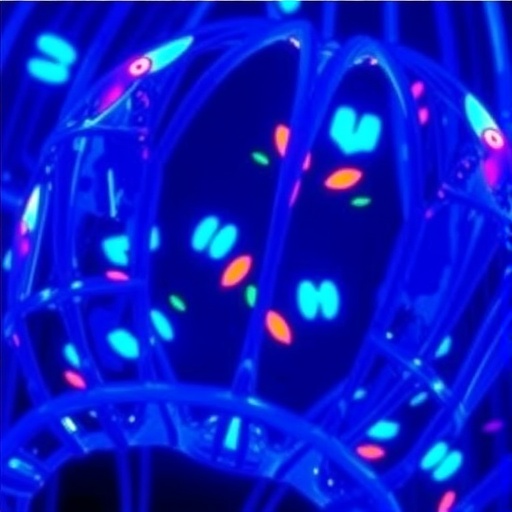In the rapidly evolving field of immunotherapy, natural killer (NK) cells have emerged as pivotal players, particularly in the context of cancer treatment. Recent groundbreaking research has unveiled critical insights into the molecular mechanisms that regulate NK cell activation and exhaustion, with a focus on a transcriptional regulator known as CREM. This novel work sheds light on how CAR signalling and IL-15 cytokine stimulation intricately govern NK cell function, potentially shaping the future of adoptive cell therapies.
The study employed sophisticated mass cytometry techniques to dissect the phenotypic landscape of CREM-expressing NK cells subjected to different stimulatory conditions. Researchers generated three distinct NK cell populations: IL-15 NK cells lacking chimeric antigen receptors (CARs), CAR70 NK cells without IL-15 secretion, and a hybrid subset termed CAR70–IL-15 NK cells that secrete IL-15 while expressing CAR70. These NK cells were co-cultured with UMRC3 cells, which express the CD70 antigen targeted by CAR70. This complex experimental framework provided a unique opportunity to parse out how CREM expression correlates with NK cell activation states.
Analyses revealed a clear hierarchy in CREM expression: CAR70–IL-15 NK cells exhibited the highest levels, followed by CAR70 NK cells, with IL-15 NK cells demonstrating the lowest expression. Such findings suggest a synergistic effect between CAR engagement and IL-15 stimulation in upregulating CREM. Mass cytometry further delineated six phenotypically distinct clusters of NK cells, each characterized by a unique constellation of surface markers and functional proteins. Of particular interest, clusters 1, 2, and 4 were predominantly represented in CAR70–IL-15, CAR70, and IL-15 NK cell populations, respectively, highlighting their differential activation signatures.
The cluster with the highest CREM expression, cluster 1, exhibited a dual expression pattern marked by robust activation alongside inhibitory markers. Notably, activation-associated molecules such as NKG2D, CD25, CD2, granzyme B, and perforin were elevated, indicating heightened cytotoxic potential. Simultaneously, this cluster upregulated inhibitory receptors including NKG2A, LAG3, TIGIT, and TIM3, markers often associated with immune exhaustion. This intriguing coexistence of activation and exhaustion phenotypes points toward a complex regulatory checkpoint, where CREM likely orchestrates a balance preventing excessive immune activation.
Examining clusters 2 and 4 revealed a tempered but similar phenotype. Cluster 2, enriched in CAR70 NK cells, and cluster 4, more abundant in IL-15 NK cells, maintained moderate expression of both activating and inhibitory markers, indicative of intermediate functional states. In stark contrast, cluster 5—prevalent in non-treated (NT) NK cells—displayed suppressed expression across both activation and inhibitory markers, consistent with a quiescent or suppressed phenotype.
Importantly, the association between elevated CREM expression and a combined activation–exhaustion immunophenotype was consistent across all experimental conditions. This widespread correlation underscores CREM’s pivotal role as a regulatory node in NK cell biology, intricately linked to the cells’ functional status. It appears that the induction of CREM is not merely a marker of activation but a key mediator of activation-induced exhaustion, potentially as a mechanism to temper immune responses and preserve cell viability.
Such discoveries have profound implications for CAR-NK cell therapy, an emergent strategy designed to harness the specificity of engineered receptors combined with the innate cytotoxicity of NK cells. The finding that CAR signalling synergizes with IL-15 to drive CREM expression suggests that while these stimuli boost NK cell activation, they may concomitantly trigger regulatory circuits that limit sustained immunity. Therefore, targeting CREM or modulating its downstream pathways could enhance the efficacy and durability of CAR-NK therapies by preventing premature exhaustion.
From a therapeutic design standpoint, these insights invite the development of next-generation CAR constructs or cytokine delivery systems tailored to fine-tune CREM activity. By decoding the molecular interplay that leads to activation-induced exhaustion, clinicians might improve persistence and potency in treated patients. Moreover, understanding CREM’s dualistic role allows for strategies that preserve beneficial activation while restraining deleterious overstimulation.
The study also presents a nuanced perspective on the phenotypic heterogeneity of NK cell populations under combined CAR and cytokine stimulation. The distinct clusters characterized by specific marker profiles emphasize the plasticity and dynamic nature of NK cell responses. Recognizing this heterogeneity is crucial for designing interventions that selectively expand optimal NK cell subsets or reprogram dysfunctional ones within immunotherapeutic contexts.
On a fundamental level, this research enriches our comprehension of NK cell biology by revealing how transcriptional checkpoints integrate signals from engineered receptors and endogenous cytokines. It prompts a reevaluation of CREM not only as a biomarker of activation exhaustion but as a potential target for enhancing immune system resilience against tumors. Additionally, it paves the way for investigations into how other transcription factors may interact with CREM to regulate NK cell fate decisions.
In conclusion, the discovery of CREM as a central regulatory checkpoint in CAR and IL-15 signalling pathways represents a significant advancement in the field of immune engineering. This study provides compelling evidence that manipulating CREM expression or function could unlock the next tier of efficacy in CAR-NK therapies, optimizing their anti-tumor capabilities. Continued exploration into the molecular circuitry governing NK cell activation and exhaustion promises to yield transformative approaches in cancer immunotherapy and beyond.
As the interface between cellular engineering and immunology deepens, the delicate balance unveiled by CREM’s regulatory role reminds us of the immune system’s complexity and precision. Harnessing such knowledge will be crucial in the design of sophisticated therapies that not only empower immune cells to attack malignancies but also safeguard against their premature attrition. With the advent of these insights, the potential of NK cells as versatile and potent effectors in the immunotherapeutic arsenal looks brighter than ever.
Subject of Research: Regulation of NK cell activation and exhaustion by CREM in the context of CAR and IL-15 signalling.
Article Title: CREM is a regulatory checkpoint of CAR and IL-15 signalling in NK cells.
Article References:
Rafei, H., Basar, R., Acharya, S. et al. CREM is a regulatory checkpoint of CAR and IL-15 signalling in NK cells.
Nature (2025). https://doi.org/10.1038/s41586-025-09087-8
Image Credits: AI Generated




